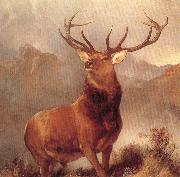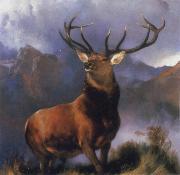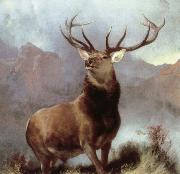
|
Sir Edwin Landseer
|
|||
|
|
|||
| 1803-1874 British Sir Edwin Landseer Galleries Landseer was something of a child prodigy whose artistic talents were recognized early on; he studied under several artists, including his father John Landseer, an engraver, and Benjamin Robert Haydon, the well-known and controversial history painter who encouraged the young Landseer to perform dissections in order to fully understand animal musculature and skeletal structure. At the age of just 13, in 1815, Landseer exhibited works at the Royal Academy. He was elected an Associate of the Royal Academy at the age of 24, and an Academician of the Royal Academy five years later in 1831. He was knighted in 1850, and although elected President of the Royal Academy in 1866 he declined the invitation. Landseer was a notable figure in 19th century British art, and his works can be found in Tate Britain, the Victoria and Albert Museum, Kenwood House and the Wallace Collection in London. He also collaborated with fellow painter Frederick Richard Lee. Windsor Castle in Modern Times (1841-1845) Queen Victoria and her family at Windsor Castle.Landseer's popularity in Victorian Britain was considerable. He was widely regarded as one of the foremost animal painters of his time, and reproductions of his works were commonly found in middle-class homes. Yet his appeal crossed class boundaries, for Landseer was quite popular with the British aristocracy as well, including Queen Victoria, who commissioned numerous portraits of her family (and pets) from the artist. Landseer was particularly associated with Scotland and the Scottish Highlands, which provided the subjects (both human and animal) for many of his important paintings, including his early successes The Hunting of Chevy Chase (1825-1826) and An Illicit Whiskey Still in the Highlands (1826-1829), and his more mature achievements such as the majestic stag study Monarch of the Glen (1851) and Rent Day in the Wilderness (1855-1868). Saved (1856) Landseer's paintings of dogs were highly popular among all classes of society.So popular and influential were Landseer's paintings of dogs in the service of humanity that the name Landseer came to be the official name for the variety of Newfoundland dog that, rather than being black or mostly black, features a mix of both black and white; it was this variety Landseer popularized in his paintings celebrating Newfoundlands as water rescue dogs, most notably Off to the Rescue (1827), A Distinguished Member of the Humane Society (1838), and Saved (1856), which combines Victorian constructions of childhood with the appealing idea of noble animals devoted to humankind ?? a devotion indicated, in Saved, by the fact the dog has rescued the child without any apparent human direction or intervention. In his late 30s Landseer suffered what is now believed to be a substantial nervous breakdown, and for the rest of his life was troubled by recurring bouts of melancholy, hypchondria, and depression, often aggravated by alcohol and drug use (Ormond, Monarch 125). In the last few years of his life Landseer's mental stability was problematic, and at the request of his family he was declared insane in July 1872. Landseer's death on 1 October 1873 was widely marked in England: shops and houses lowered their blinds, flags flew at half-staff, his bronze lions at the base of Nelson's column were hung with wreaths, and large crowds lined the streets to watch his funeral cortege pass (Ormond, Monarch 135). Landseer was buried in St Paul's Cathedral, London . | |||
|
|
|||
|
Monarch of The Glen new4/Sir Edwin Landseer-475425.jpg Painting ID:: 31340 |
nn07 24 x 26 in | ||
|
|
|||
|
Sir Edwin Landseer
|
|||
|
|
|||
| 1803-1874 British Sir Edwin Landseer Galleries Landseer was something of a child prodigy whose artistic talents were recognized early on; he studied under several artists, including his father John Landseer, an engraver, and Benjamin Robert Haydon, the well-known and controversial history painter who encouraged the young Landseer to perform dissections in order to fully understand animal musculature and skeletal structure. At the age of just 13, in 1815, Landseer exhibited works at the Royal Academy. He was elected an Associate of the Royal Academy at the age of 24, and an Academician of the Royal Academy five years later in 1831. He was knighted in 1850, and although elected President of the Royal Academy in 1866 he declined the invitation. Landseer was a notable figure in 19th century British art, and his works can be found in Tate Britain, the Victoria and Albert Museum, Kenwood House and the Wallace Collection in London. He also collaborated with fellow painter Frederick Richard Lee. Windsor Castle in Modern Times (1841-1845) Queen Victoria and her family at Windsor Castle.Landseer's popularity in Victorian Britain was considerable. He was widely regarded as one of the foremost animal painters of his time, and reproductions of his works were commonly found in middle-class homes. Yet his appeal crossed class boundaries, for Landseer was quite popular with the British aristocracy as well, including Queen Victoria, who commissioned numerous portraits of her family (and pets) from the artist. Landseer was particularly associated with Scotland and the Scottish Highlands, which provided the subjects (both human and animal) for many of his important paintings, including his early successes The Hunting of Chevy Chase (1825-1826) and An Illicit Whiskey Still in the Highlands (1826-1829), and his more mature achievements such as the majestic stag study Monarch of the Glen (1851) and Rent Day in the Wilderness (1855-1868). Saved (1856) Landseer's paintings of dogs were highly popular among all classes of society.So popular and influential were Landseer's paintings of dogs in the service of humanity that the name Landseer came to be the official name for the variety of Newfoundland dog that, rather than being black or mostly black, features a mix of both black and white; it was this variety Landseer popularized in his paintings celebrating Newfoundlands as water rescue dogs, most notably Off to the Rescue (1827), A Distinguished Member of the Humane Society (1838), and Saved (1856), which combines Victorian constructions of childhood with the appealing idea of noble animals devoted to humankind ?? a devotion indicated, in Saved, by the fact the dog has rescued the child without any apparent human direction or intervention. In his late 30s Landseer suffered what is now believed to be a substantial nervous breakdown, and for the rest of his life was troubled by recurring bouts of melancholy, hypchondria, and depression, often aggravated by alcohol and drug use (Ormond, Monarch 125). In the last few years of his life Landseer's mental stability was problematic, and at the request of his family he was declared insane in July 1872. Landseer's death on 1 October 1873 was widely marked in England: shops and houses lowered their blinds, flags flew at half-staff, his bronze lions at the base of Nelson's column were hung with wreaths, and large crowds lined the streets to watch his funeral cortege pass (Ormond, Monarch 135). Landseer was buried in St Paul's Cathedral, London . | |||
|
|
|||
|
Monarch of the Glen new9/Sir Edwin Landseer-337873.jpg Painting ID:: 32810 |
mk81 1851 | ||
|
|
|||
|
Sir Edwin Landseer
|
|||
|
|
|||
| 1803-1874 British Sir Edwin Landseer Galleries Landseer was something of a child prodigy whose artistic talents were recognized early on; he studied under several artists, including his father John Landseer, an engraver, and Benjamin Robert Haydon, the well-known and controversial history painter who encouraged the young Landseer to perform dissections in order to fully understand animal musculature and skeletal structure. At the age of just 13, in 1815, Landseer exhibited works at the Royal Academy. He was elected an Associate of the Royal Academy at the age of 24, and an Academician of the Royal Academy five years later in 1831. He was knighted in 1850, and although elected President of the Royal Academy in 1866 he declined the invitation. Landseer was a notable figure in 19th century British art, and his works can be found in Tate Britain, the Victoria and Albert Museum, Kenwood House and the Wallace Collection in London. He also collaborated with fellow painter Frederick Richard Lee. Windsor Castle in Modern Times (1841-1845) Queen Victoria and her family at Windsor Castle.Landseer's popularity in Victorian Britain was considerable. He was widely regarded as one of the foremost animal painters of his time, and reproductions of his works were commonly found in middle-class homes. Yet his appeal crossed class boundaries, for Landseer was quite popular with the British aristocracy as well, including Queen Victoria, who commissioned numerous portraits of her family (and pets) from the artist. Landseer was particularly associated with Scotland and the Scottish Highlands, which provided the subjects (both human and animal) for many of his important paintings, including his early successes The Hunting of Chevy Chase (1825-1826) and An Illicit Whiskey Still in the Highlands (1826-1829), and his more mature achievements such as the majestic stag study Monarch of the Glen (1851) and Rent Day in the Wilderness (1855-1868). Saved (1856) Landseer's paintings of dogs were highly popular among all classes of society.So popular and influential were Landseer's paintings of dogs in the service of humanity that the name Landseer came to be the official name for the variety of Newfoundland dog that, rather than being black or mostly black, features a mix of both black and white; it was this variety Landseer popularized in his paintings celebrating Newfoundlands as water rescue dogs, most notably Off to the Rescue (1827), A Distinguished Member of the Humane Society (1838), and Saved (1856), which combines Victorian constructions of childhood with the appealing idea of noble animals devoted to humankind ?? a devotion indicated, in Saved, by the fact the dog has rescued the child without any apparent human direction or intervention. In his late 30s Landseer suffered what is now believed to be a substantial nervous breakdown, and for the rest of his life was troubled by recurring bouts of melancholy, hypchondria, and depression, often aggravated by alcohol and drug use (Ormond, Monarch 125). In the last few years of his life Landseer's mental stability was problematic, and at the request of his family he was declared insane in July 1872. Landseer's death on 1 October 1873 was widely marked in England: shops and houses lowered their blinds, flags flew at half-staff, his bronze lions at the base of Nelson's column were hung with wreaths, and large crowds lined the streets to watch his funeral cortege pass (Ormond, Monarch 135). Landseer was buried in St Paul's Cathedral, London . | |||
|
|
|||
|
monarch of the glen new20/Sir Edwin Landseer-623556.jpg Painting ID:: 56232 |
mk247 1851,oil on canvas,64.5x66.5 in,163.8x169 cm,john dewar and sons ltd,london,uk | ||
|
|
|||
|
Also Buy::. For Following Paintings / Artists / Products, Please Use Our Search Online: |










